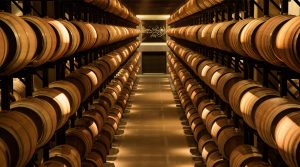Xarel.lo is part of the trio of grapes that make up the famous Catalan cava, together with Macabeo and Parellada, and it is a white grape variety native to Catalonia that provides body, structure and acidity. However, this grape is also planted in the rest of Spain as it has magnificent characteristics as well as withstanding temperature changes. If you want to know more about this type of grape, keep reading this post and don’t miss any detail!
The origin of the xarel·lo grape

This grape variety was first mentioned under the name “xerello” in 1785 in Sitges, in a lease contract of “la Torre de Sitges”. At that time, the xarel-lo grape was not at all popular, in fact, it was on the verge of disappearing, as its aroma and structure did not convince the inhabitants of a society where softer wines were preferred.
However, one of the properties that characterize this white grape was discovered when the wines were transported from one territory to another, which at that time was done by sea and land without stabilization. Since then, the xarel-lo grape proved to be the only one of all the varieties that arrived at its destination fresh and in perfect condition, thanks to its antioxidant character. From then on, the winegrowers of Catalonia saw a good opportunity in the replanting of this grape variety, which was initially sold for six cents a barrel to the Americas due to its low popularity, and with the demand of the French market it began to be sold at 60 cents.
No one understood why this grape without much expression and high acidity was not only able to withstand long trips without a problem, but also to age in bottle for years creating cavas of long aging and great quality. The answer came in the late 1990s, when scientific studies from the University of Barcelona or the University of Washington showed that Xarel-lo is the variety that contains the highest levels of antioxidants of all, including some reds.
Characteristics of the xarel·lo grape
As we have mentioned, xarel·lo was on the verge of extinction in the 19th century, but not only did it manage to survive, but it is currently the most widely planted white grape in the Penedés region.
Generally speaking, xarel·lo is a variety of great vigor and semi-upright growth, with very early budding and early to medium ripening. The grapes are of medium size, between 300 and 350 berries and of low compactness. The berries are spherical, thick-skinned and golden in color, with a thick and consistent skin, but sensitive to rubbing and with little bloom.
On the other hand, the flesh, hard and juicy, is colorless, tends to darken when ripe and has a fruity flavor. Its bunches are also medium-sized, very tight and ovoid in shape, with compact, round berries, strong skin and very sweet. The vine is vigorous and very productive, with a lying posture and a lot of branching of thick shoots, with a very adequate leaf removal to maintain the health and homogeneity of ripening in its clusters.
Here are some other characteristics to keep in mind about xarel·lo:
- It adapts to warm and dry climates and its vegetative cycle works best between 0 and 400 meters above sea level.
- It is resistant to wind and possible late spring frosts.
- The vines of this grape are characterized by a drooping growth habit, with many rather thick branches.
- They are susceptible to runner, but can be managed with good pruning, leaving some long ones.
- It is very sensitive to diseases such as mildew, powdery mildew and botrytis, as it has compact clusters.
- It is also sensitive to moth and mite attacks.
Xarel·lo growing areas

Xarel·lo is grown mainly in the Penedés, Tarragona and the Balearic Islands, from sea level to 400 meters above sea level. It is the most cultivated variety in this appellation of origin a few kilometers from the city of Barcelona. In the Penedés more than 90% of the vineyard extension is dedicated to white varieties, mostly xarel·lo. There it finds the most suitable climatic conditions for its development. Protected from cold winds by the mountains of Montserrat; a few kilometers from the Mediterranean Sea that exerts a great influence; and at an altitude of between 250 and 800 meters with mild and warm temperatures.
Although it is grown especially in Catalonia, due to its characteristics it is also planted in the rest of Spain, for example in Castilla la Mancha, Castilla León, Extremadura, Aragón, La Rioja, Zaragoza, Navarra, Valencia and Badajoz, as it is productive, rustic and adapts very well to warm and dry climates.
Guided visits to the best wine cellars
If you are a lover of good wine and you are looking for a guided tour of the best wine cellars, in Taca de Vi we have what you are looking for! We offer you the possibility to take one of our complete wine tours through different locations in the most renowned wine cellars, an ideal experience to surprise your family, friends, or any wine lover.
In Taca de Vi we want to show the richness of Catalan wine and we would love to take you to visit the most reputable wineries of the most prestigious regions during your stay in the Catalan capital. We will organize a private wine tour in Barcelona, where you can feel the texture of the soil of the vineyard, the aroma of the wine in the cellar or listen to the experience and stories of the winemaker. Take a look at our website!









